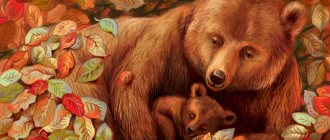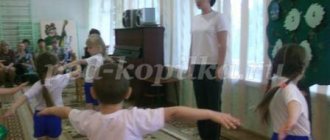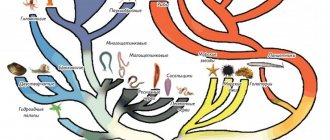Preparatory group. Senior preschool age. Children 6-7 years old
Notes in the preparatory group on familiarization with the outside world “Road Rules” Municipal budgetary preschool educational institution, child development center kindergarten No. 10 “Rainbow”
Summary of direct educational activities to
familiarize yourself with the outside world in the preparatory group “Road Rules”
in the form of the game “What? Where?…
Summary of a lesson on familiarization with the outside world and development of speech “Utensils” for children of senior preschool age Synopsis of a lesson on familiarization with the outside world and development of speech on the topic: “Utensils”
. Program content: Correctional educational objectives: Clarify children's understanding of dishes, their purpose, details and parts of which they consist; the materials from which it is made;…
Study of physical phenomena
For such classes, the teacher will not need a laser, oscilloscope or synchrophatron. A preschooler needs to be introduced to the phenomenon of floating bodies. To do this, various objects are lowered into a basin of water. As a result of the experiment, the child finds out which of them sinks and which remains on the surface.
Other experiments may be carried out. For example, by dissolving a substance in water. For this you will need a glass. Warm water is poured into it. A spoonful of sugar or salt is poured into a glass. First, the teacher should ask the children what they think will happen next. Most likely they will be able to answer correctly. Yes, the sugar or salt has dissolved. Maybe they have completely disappeared? No. Children must understand that substances have changed into another state.
Familiarity with physical phenomena gives children an understanding of the properties of various materials. Some of them are solid (stone, wood, metal). If you put pressure on them, they will not change their shape. There are also soft materials. These are cotton wool, fabric and plasticine. When pressed, their shape changes quite easily. There are also materials that feel hard to the touch (faience, glass), but can easily break.
Lesson on the surrounding world on the topic “Autumn” in the preparatory group
Summary of a lesson using ICT in the preparatory group on the topic: “Journey to the autumn forest”
Purpose: Creating a social situation for development through the formation of cognitive activity and creative imagination in children. Objectives: 1. Create conditions for generalizing, clarifying and expanding children’s ideas and knowledge about autumn, wild animals, birds. 2. Create conditions for the development of memory, attention, phonemic perception, freely use simple sentences, develop the ability to actively engage in verbal communication, express your opinion, assumption. 3. Create conditions for children to develop ideas about autumn and animal life through ICT technologies. 4. Activate vocabulary on the topic, develop the ability to behave in the forest. 5. Cultivate a love for nature and a caring attitude towards it. Preliminary work: a virtual excursion into nature through the autumn forest, asking riddles, looking at illustrations, reading fiction (S. Mikhalkov “Greedy Hare”, G. Bullfinch “Bear Cub”)
.
Modeling classes.
Didactic games: “Hunter”, “When does this happen”, “Who eats what?”
Vocabulary: September, October, November, leaf fall, wind, light, golden, crimson, etc. Names of wild animals, migratory and wintering birds. Material used: pictures of migratory and wintering birds, samples of tree bark, aspen and spruce branches, pine cones. Musical accompaniment by Vivaldi "Autumn". P.I. Tchaikovsky "Seasons", presentation "Autumn Forest". Equipment: Laptop, video projector, screen, presentation: “Autumn Forest.”
Progress OD
Org. moment The group organized an exhibition of children's works on the theme: “Autumn has come to visit us.” Children stand in a circle. Educator: Let's play with you Hedgehog Along a dry forest path - Top - top - top - feet are stomping. A gray hedgehog covered in needles walks and wanders along the dorzhek. Looking for berries, mushrooms for my son or daughter. (Arms bent in front of the chest, hands down. Legs slightly bent at the knees, takes small, frequent steps) Educator: Guys, is everyone in a good mood? Close your eyes and listen to what you hear now (audio recording of the sounds of an autumn forest)
.
The teacher opens the presentation “Autumn Forest”, the children carefully look at the screen
.
(Slide – painting “Autumn Forest”)
.
Main part Educator: Today we will go with you to the autumn forest. But in order to find ourselves there, we need to solve a riddle, because we need to go there on something, but on what?! A riddle will help us with this : (Slide – bicycle)
It has two wheels and a saddle on the frame.
There are two pedals below, you spin them with your feet. (Bicycle) Children answer. Educator: That's right, guys, we'll go to the forest on a bicycle, let's lie down on the carpet and start pedaling (children do the bicycle exercise)
.
Look at the screen, now we have arrived at a forest clearing. Guys, let's remember how to behave in the forest? The children answer. Educator: 1. Know how to behave in the forest, on a walk, outside the city: don’t shout, don’t scare wild animals. They love kind children. 2. Don’t pick flowers, hundreds of people will follow you, and they will also be pleased to see flowers. 3. Don’t break trees in vain, don’t make carvings on them. … 4. Do not catch butterflies, ants and other animals for fun. 5. Don't litter in the forest. Wind recording sounds. Educator: Guys, do you hear? What are these sounds? Children: the wind is blowing. Educator: That's right, a light autumn breeze is blowing. (Slide with a clearing)
.
Let's also try to make a breeze, as we know how. Exercise “Breeze” I am a strong wind, I am flying, I am flying wherever I want (arms are lowered, legs slightly apart, inhale through the nose)
I want to whistle to the left
(turn my head to the left, lips with a tube and blow)
I can blow to the right
(head straight, inhale, head to the right, lips in a tube, exhale)
I can go up
(head straight, inhale through the nose, exhale through the lips with a tube, inhale)
And into the clouds
(lower my head, touch my chin to my chest, calmly exhale through my mouth)
In the meantime, I’m dispersing the clouds
(circular movements hands)
.
(children do a breathing exercise) Reading the poem “Autumn” by E. Trutnev In the morning we go into the yard - Leaves are falling like rain, rustling under our feet And flying... flying... flying... Cobwebs fly by with spiders in the middle, And cranes fly high from the ground. Everything is flying! This must be our summer flying away. Educator: What time of year is the poem talking about? Children: The poem talks about autumn. Educator: That’s right, autumn is all around and autumn has come in the forest too. Guys, what can we say about the forest in autumn? What is he like? Children: Autumn forest. Educator: Let's remember those who live in the forest. Look at the screen, there is a hint for you. (Slide with images of animals) Children: Animals, birds (they call animals, birds) Educator: Now let’s play a game and our screen will help us with this. Didactic game “Which one, which one?” Wolf (Which one?)
– angry, hungry, gray Bear
(Which one?)
– big, strong, brown Fox
(Which one?)
– cunning, cautious, red Hare
(Which one?)
– cowardly, small, gray, white Squirrel
(Which one?)
– thrifty, nimble.
Educator: Well done, you decided on the animals and described each of them. Can we handle another task? Didactic game “Who lives where?” In the hollow lives... (squirrel)
, In the den lives...
(wolf)
, Under the bush trembles...
(hare)
, In winter in the den....
(bear)
, In a hole...
(fox)
, In a hut under water...
(beaver)
.
Physical exercise “Autumn” We sweep the paths (imitation movements)
Collect leaves into piles
(bend over, imitate movement)
So that while walking, the kids have fun from the heart!
(jumping in place)
Oh, we’re tired
(“wipe the sweat from your forehead”)
Let’s rest
(sit down)
And let’s go home quickly
(steps in place) Educator: Autumn is a very beautiful time of year. The red summer flashed by unnoticed. Beautiful autumn has arrived. She waved her wide sleeves and the green leaves turned yellow, crimson, red (slides depicting an autumn forest)
.
At the beginning of autumn, dahlias, asters, and calendula began to bloom in the gardens and sparkle with different colors. Among the trees, rowan is particularly beautiful. Rowan berries are not afraid of the cold. The first frost is not scary for them, they only become sweeter, the frost kills the bitterness in them. But now the first month of autumn has passed - September, and is being replaced by October. It is already noticeable that the days are getting shorter and the nights are getting longer. The sun began to appear less often in the sky, it was cloudy and rainy. The naughty wind likes to play with trees, he sways them, tears off leaves from them. Leaves fly in the wind, cover the ground and form a multi-colored carpet on the ground. This phenomenon is called leaf fall. Leaves fall and fall, and soon the trees and bushes shed their last leaves. You look at them, but there are no leaves on the trees. This is how they prepare for winter. The trees are resting, stocking up on new strength in order to wake up in spring. At this time, the cranberries in the forest became red and plump. A bold berry, it will overwinter under the snow, and in the spring the snow will melt, go and pick it. (slides)
There are also lingonberries, which serve as food for birds: capercaillie, grouse, and hazel grouse.
October flies by unnoticed and the last month of autumn, November, arrives. In November, the breath of winter can already reach us. The weather changes almost every day. One day, it seems that it is still autumn, but sometimes it will snow, as if real winter has come. Yes, and no frost, no, and it will show its character. The rivers are first covered with a thin crust of ice, and even then mainly at night, and during the day the sun can still melt the ice, and the river runs again, rejoicing that the frost has not shackled it. At the end of November, it is clear that all nature is ready for the arrival of Mother Winter, and is waiting for her. How do animals in the forest prepare for winter during the autumn months? You go into the forest, it seems quiet, only the wind is blowing. But this is not so, the forest lives its own life, inaccessible to prying eyes. Forest residents are actively preparing for winter. The squirrel and the hare, like true fashionistas, are preparing to change their skins. Winter skins are warmer, and the color is different, making it easier to hide from predators. The hare was gray, will become white. In late autumn the hare has a hard time, the skin is gray, and in the fall the first snow already appears in some places, the hare cannot hide anywhere from either predators or hunters. (slides)
The squirrel will change its red skin to gray.
All summer the squirrel worked, preparing for winter. The hard worker collected berries, cones, and hid nuts in different places, her pantries. If none of the animals ruins them, the squirrel will have enough for the whole long winter. - Guys, in kindergarten you and I go for a walk. We hung a feeder on our site and pour food into it. (slides)
Who is that running, rustling the leaves, shur-shur-shur?
Ah.. so this is a hedgehog, running, in a hurry, preparing for winter. The hedgehog is a predator that feeds on small insects and, less often, vegetation. Running along a forest path, looking for food: beware of forest animals! The hedgehog tries to gain as much fat as possible before winter. For his mink, the hedgehog digs a hole in the ground, drags grass and leaves into it. In winter, the hedgehog hibernates until spring. (slides)
.
The “master of the forest” the bear sleeps in winter, and the bear fattens up in summer and autumn. The bear is an omnivore, he loves Toptygin and berries and tree roots, a noble fisherman, oh, how he loves to eat fish. (slide)
The badger is also preparing its home for hibernation.
(slide)
Frogs, snakes, lizards, and toads also hibernate.
(slide)
Even the insects were no longer visible; some hid under the bark of trees and others in the ground.
A river runs along the forest. Beavers work by the river, make a burrow for the winter, prepare logs for the hut, (that’s the name of their home)
branches for food in the winter.
(slide)
Bird voices were no longer heard in the forest.
At this time, birds gather in flocks and fly away to warmer regions. First, insectivorous birds fly away, then granivorous birds, then swamp and aquatic ones. (Slide)
.
This is how the animals of the forest prepare for the coming of winter. I read a story about autumn to you, about its signs, and its beauty, and how in the forest, animals greet autumn, and prepare supplies for winter! Educator: This is how animals live in the autumn forest. And now it’s time for us to go back to kindergarten. Let's lie down again and pedal our bike. (slide bike)
, children lie on the floor and perform bicycle movements to the music.
Educator: So we returned to kindergarten again. Did you like it in the forest? What birds and animals did we talk about today? Well done, you performed very well on our excursion! You are true friends of nature. And here are some treats from the forest dwellers.
We recommend watching:
Synopsis of a comprehensive lesson for children of the preparatory group on the topic: Autumn Synopsis of the educational instruction in drawing for children of the preparatory group of a preschool educational institution. Autumn rowan GCD on cognitive development in the preparatory group on the topic “Autumn” Summary of SOD in the preparatory group on the topic: Autumn
Similar articles:
Scenario of the autumn ball in the senior preparatory group of the preschool educational institution
Summary of an autumn walk in the preparatory group “Observing a sparrow in autumn”
Summary of an autumn walk in the preparatory group “Observing pigeons”
Summary of a walk in the preparatory group “Observing a poplar”
Summary of the walk in the preparatory group “Observing seasonal changes in November”





